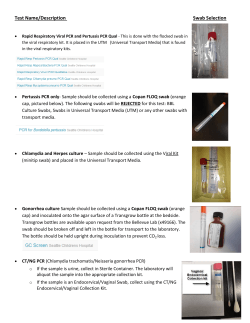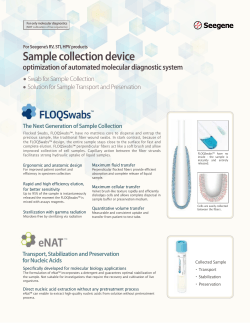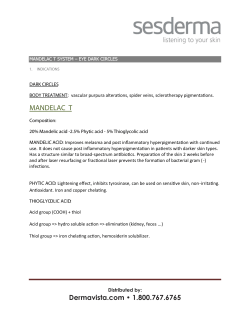
Clinical Microbiology and Virology Transport
Clinical Microbiology and Virology Transport Refer to the MLabs Test Catalog for specific specimen type and volume requirements for a particular test or tests. Aerobic Transport (BD ESwab Kit) A sterile package containing a polypropylene screw-cap tube filled with 1 mL of liquid Amies transport medium and a specimen collection swab that has a tip flocked with soft nylon fiber. To use, remove the cap and touch swab to specimen site and obtain as much specimen as possible. Insert the swab into the tube and bend the swab shaft at the marked breakpoint against the tube to break the shaft. Replace cap on tube and secure tightly. Specimens include throat, wound, and urogenital specimens. Do not use for Bordetella. Anaerobic Transport A sterile, glass, screw-cap tube containing oxygen-free gas, an agar medium, and oxygen indicator. Discard if the agar is purple. To use for fluid or tissue, keep the tube upright and carefully open cap. Layer fluid or tissue on top of the medium and screw the cap on tightly. Anaerobic specimens include tissue, aspirate, wound, abscess, body fluids, endometrium, transtracheal aspirates, and suprapubic urine. Urine C & S Transport Kit A gray top, vacutainer tube containing Lyophilized Urine Maintenance Formula, which prevents the proliferation of bacteria in specimens that must remain at room temperature for an extended period prior to transport to the laboratory. To use, place the straw of the transport device into the urine specimen so that the tip of the straw is below the surface of the urine and close to the bottom of the urine container. Push the tube into the plastic holder portion of the transfer device so that the metal puncture point pierces the gray stopper of the tube. Urine will flow into the tube via vacuum pressure; hold the straw in position until the urine stops flowing into the tube. Shake vigorously to mix. Note: this kit is only for microbiology urine cultures; the specimen cannot be used for urinalysis or any urine chemistry test. Sterile Container A sterile round plastic cup with screw cap. Place specimen in container and screw the cap on tightly. Specimens include tissue, fluids, aspirates, urine, sputum, bronchial washing, nails, scrapings, foreign bodies, stools and rectal swabs for rotavirus and adenovirus antigens, and stools for Clostridium difficile. Page 1 of 5 Rev. 5/11/2015 MLAB-OPS-J-001 Clinical Microbiology and Virology Transport Blood or Sterile Body Fluids Transport Set (Aerobic & Anaerobic bottles for Bacteria and Yeast) Two (2) BacT/Alert bottles (green & orange caps) containing 40 mL of liquid broth to be used as a set, or individually (green cap) for aerobic-only cultures. For pediatric or low volume draws, use only the aerobic bottle. To use, wipe stopper with 70% alcohol, allow to dry, and inject an appropriate amount of blood: Aerobic (Green) BacT/Alert bottle – Infant to 10 years: 1-5 mL; 10 years to Adult: 8-10 mL; for sterile body fluids (e.g., peritoneal or dialysate fluid): 1-10 mL. Anaerobic (Orange) BacT/Alert bottle – Infant to 10 years: Do Not Use; 10 years to Adult: 8-10 mL; for sterile body fluids (e.g., peritoneal or dialysate fluid): 1-10 mL Adult (Large) Isolator Tube A 10 mL glass tube, with yellow and black stopper, containing 1 mL liquid. To use, wipe stopper with 70% alcohol, allow to dry, fill with blood and invert to mix. Use for Blood Culture for AFB or Fungus. Pediatric (Small) Isolator Tube A 1.5 mL glass tube, with yellow stopper, containing a small amount of fluid. To use wipe stopper with 70% alcohol, allow to dry fill with blood and invert to mix. Use for Blood Culture for AFB or Fungus, and Bone Marrow Cultures. Swube Tube Transport (Pinworm Paddle) A plastic paddle with glue on one side sealed in a plastic container. To use, touch sticky side of paddle to skin around perianal area and return paddle to plastic container. Ova and Parasite Kit (O&P) – ECOFIX TM A single plastic vial with green screw cap, containing liquid. To use, fill vial with stool to red line using a tongue depressor or the spoon attached to lid of vial. Cap tightly and mix or shake well until stool is completely emulsified. Use for Ova and Parasite exams including Cryptosporidia and Microsporidia Exams. Do not use for Clostridium difficile, Giardia Antigen, or Fungus Culture. Page 2 of 5 Rev. 5/11/2015 MLAB-OPS-J-001 Clinical Microbiology and Virology Transport Stool Culture Transport A single plastic vial with orange screw cap, containing non-nutritive, stool transport solution. To use, fill vial with stool to red line (30 mL) using a tongue depressor or the spoon attached to lid of vial. Cap tightly and mix, or shake well, until stool is completely emulsified. Use for bacterial or yeast stool cultures, Giardia Antigen, fecal leukocyte screen, and shiga-like toxin testing. Do not use for Clostridium difficile. OCS Collection Kit for Fecal Occult Blood (IFOB) (Chemistry Lab) Collect feces from the sample collection paper or specimen caught in a clean cup or collected during routine physical exams during the visit (i.e. DRE). Contamination from toilet water should be avoided. 1. Fill in the patient demographic information on the sampling bottle. Open the green cap by turning to the left and pulling upwards. 2. Randomly scrape the surface of the fecal sample with the sample probe. Cover the grooved portion of the sample probe completely with stool sample. 3. Close the sampling bottle by inserting the sample probe and screwing cap on tightly to the right. Do not reopen. The inoculated sample may be stored at room temperature for up to fifteen (15) days or can be refrigerated at 2-8 degrees C for up to thirty (30) days. Viral Slides 3-well, black Teflon coated slides; send 2 or 3 slides. Scrape the base and periphery of the lesion with a sharp instrument or vigorously rub with a dry swab. Gently roll the cells onto the slide, rolling each well separately. Allow the slide to air dry and refrigerate. Specimens include lesions for Herpes simplex or Varicella zoster virus antigens. M4-RT Transport for Viruses, Chlamydia Culture, and Bordetella DNA Transport kit includes a vial of M4-RT (conical tube with a red cap containing pink fluid with glass beads) as well as large (vaginal or cervical) and small (urethral or nasopharyngeal) plastic, flexible flocked swabs. The un-inoculated kits can be stored at room temperature. Discard if there is evidence of contamination or the color has changed from light pink. To use, collect specimen with swab, insert into transport media, break off shaft (leave swab in transport), tighten lid securely, and refrigerate. Do not use cotton swabs, calcium alginate swabs or woodenshafted swabs. Specimens include respiratory, urogenital, sterile tissue, and sterile body fluids. PreservCyt for HPV A vial containing 3 mL PreservCyt liquid. Collect cervical specimen and place into ThinPrep/PreservCyt vial. Store and transport at room temperature. Use for Human Papillomavirus (HPV) DNA Profile. Page 3 of 5 Rev. 5/11/2015 MLAB-OPS-J-001 Clinical Microbiology and Virology Transport BD ProbeTec CT/GC Transport (Endocervical for Chlamydia trachomatis and Neisseria gonorrhoeae DNA) Includes cleaning and female endocervical swabs and ProbeTec transport tube. Clean excess mucus from the cervical os and surrounding mucosa using the white shaft cleaning swab or other cleaning swab of choice. Discard cleaning swab; do not use white shaft cleaning swab to collect sample. Insert the small PINK swab from the collection kit 1 to 1.5 cm into the endocervical canal, rotate the swab clockwise for 15 to 30 seconds, and draw the swab back carefully avoiding any contact with the vaginal mucosa. Insert the swab all the way into the transport media immediately after specimen collection and bend the shaft of swab against the tube to break shaft; it is scored to break easily if the swab is inserted completely into transport. Tighten lid of transport securely. BD ProbeTec CT/GC Transport (Urethral for Chlamydia trachomatis and Neisseria Gonorrhoeae DNA) Includes male urethral swab and ProbeTec transport tube. Insert the small BLUE swab from the collection kit 2 to 4 cm into the urethra, rotate clockwise for 3 to 5 seconds and withdraw. Insert the swab all the way into the transport media immediately after specimen collection and bend the shaft of swab against the tube to break shaft; it is scored to break easily if the swab is inserted completely into transport. Tighten lid of transport securely. BD ProbeTec CT/GC Transport (Urine for Chlamydia trachomatis and Neisseria Gonorrhoeae DNA) Includes Urine Preservative Transport (UPT) and pipette. Patient should not void for at least 1 hour prior to specimen collection. Collect the first 20 to 60 mL of voided urine into a sterile plastic container. Using a pipette, transfer 2 - 3 mL of urine into a BD ProbeTec Urine Preservative Transport (UPT) tube; fluid levels should be between black arrows on the fill window of the UPT label. Urine should be transferred to UPT within 8 hours of collection if stored a room temperature or within 24 hours if kept refrigerated. BD ProbeTec CT/GC Transport (Vaginal for Chlamydia trachomatis and Neisseria Gonorrhoeae DNA) Includes vaginal specimen transport with swab. Patient collected vaginal swab specimens are an option for screening women when a pelvic exam is not otherwise indicated; it is not for home use. Ensure the patient washes hands with soap and water. The patient should collect the sample by holding the swab with one hand and spreading skin outside the vagina. She should then insert the tip of the swab into the vaginal opening no more than 2 inches, gently rotate for 10 to 15 seconds, withdraw the swab and place the swab in the transport tube and cap securely. After collection, the patient should wash her hands and return the tube to the clinician. Page 4 of 5 Rev. 5/11/2015 MLAB-OPS-J-001 Clinical Microbiology and Virology Transport InPouch TV collection for Trichomonas vaginalis The InPouch TV (IPTV) supports the growth of Trichomonas vaginalis while inhibiting the growth of other organisms. It can be used for transport, microscopic viewing and culture. Keep at room temperature, refrigeration will destroy T. vaginalis. Inoculate the IPTV by folding pouch back over itself to reduce the folded crease. Squeeze the fluid from the top of the pouch downward to avoid fluid leakage. Tear open the pouch at the notch just above the closure. Open the pouch by pulling the closure tabs apart sufficiently to inoculate the specimen. Inoculate the upper chamber of the IPTV - Swab: gently press it between the walls of the pouch. Discard the swab. Liquid: inoculate 1-2 drops of specimen sediment. Express the contents of the upper chamber into the lower chamber. Roll down the pouch and fold over the wire tape tabs to lock the roll. Specimens collected for Trichomonas vaginalis Culture can also be sent in Aerobic Transport. Scotch Tape Prep Requires a clean slide, clear transparent tape, slide container and envelope. Do not use frosted or "magic" tape. Stick tape onto one side of labeled clean glass slide, sticky side down. Do not wrap tape around slide. After collection place slide in slide container, tape shut, place slide container in envelope and tape closed. Package slide to prevent breakage. Vacutainer Tubes Sterile glass tube containing vacuum and various additives. To use wipe stopper with 70% alcohol and inject blood or bone marrow specimen, or collect specimen directly into vacutainer tube. Invert several times to mix. See the Order of Draw for Multiple Tube Collections document for additional information. Page 5 of 5 Rev. 5/11/2015 MLAB-OPS-J-001
© Copyright 2025









